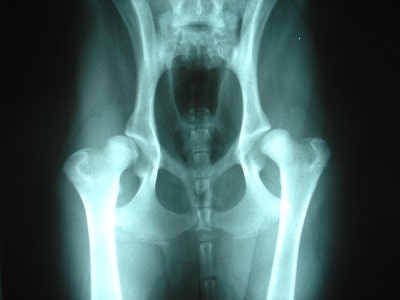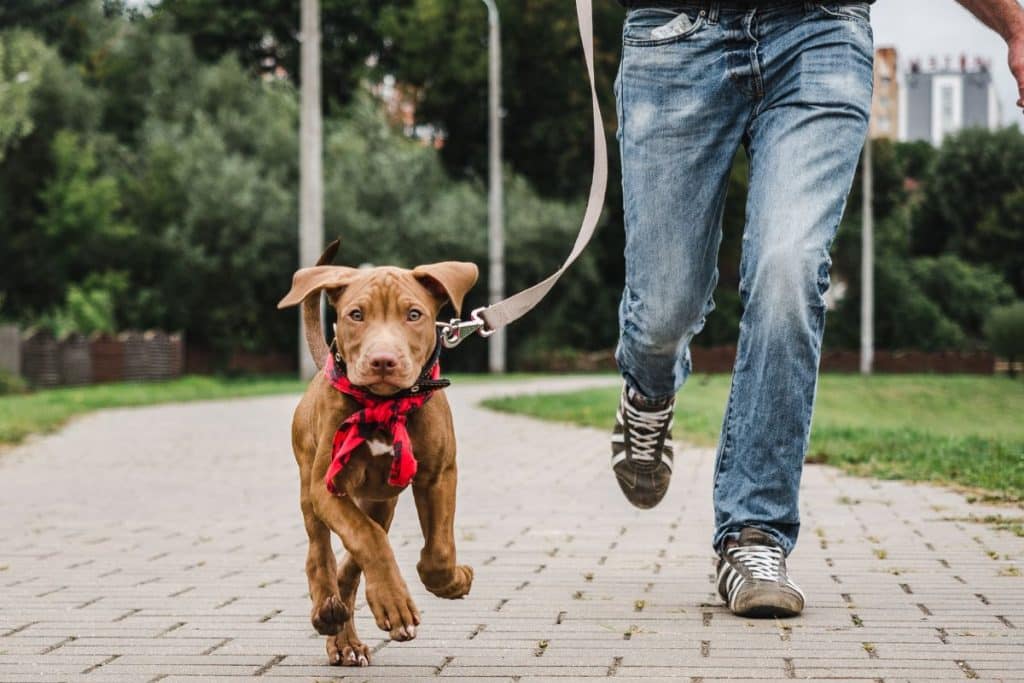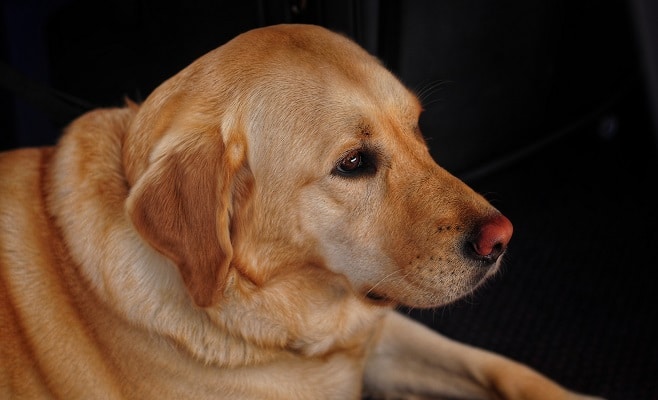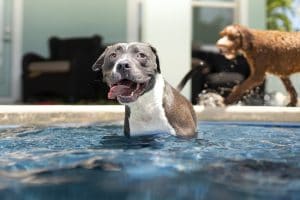Like us, dogs can also suffer from a variety of health issues, one of which is hip dysplasia.
Hip dysplasia is a disease that makes the joints not grow properly and become misaligned, leading to uncomfortable movement and constant pain. It leads to a severe downgrade in a dog’s quality of life as one of the things they enjoy the most is taken away from them – movement and play.
Sadly, there’s no cure for hip dysplasia, but there are many things an owner can do to help manage it as best as possible.
Regular exercise is the best way to contain and manage hip dysplasia. However, given your pooch’s condition, that’s easier said than done. Fortunately, several easy exercises can help alleviate the symptoms of hip dysplasia and improve your dog’s quality of life.
Let’s start with understanding the problem and assessing the situation.
How does hip dysplasia happen, and what does it mean?
Hip dysplasia is a genetic condition most commonly seen in larger dog breeds, although smaller dogs can also be affected. It occurs when the ball and socket joint of the hip don’t fit together correctly, causing friction on the joint. Over time, this can lead to arthritis, pain, and difficulty walking.
Besides genetics, factors like obesity, poor nutrition, and lack of exercise can also increase the risk of developing hip dysplasia in dogs. Early detection and intervention are crucial to managing hip dysplasia and preventing it from becoming more severe.
So, let me first address the elephant in the room, “Can hip dysplasia be fixed with exercising?”
Hip Dysplasia is an incurable disease that you can’t fix with exercising. However, it can contain and manage the problem and resolve lifestyle issues. Exercise helps keep the joints mobile and can reduce pain and stiffness. It also helps maintain a healthy weight, benefiting dogs with hip dysplasia.

Low-impact exercises like swimming and walking are great options, as they help strengthen the muscles around the hip joint without putting too much stress on it. These exercises can also help improve circulation and reduce inflammation in the joint.
Generally, dogs with hip dysplasia must not indulge in high-energy activities such as running. Although they’re free to walk provided, they get plenty of rest and other exercises.
Top 10 Exercises for Dogs with Hip Dysplasia
1. Simple short walks
Walking is an excellent low-impact exercise for dogs with hip dysplasia. Start with short walks and gradually increase the duration over time. Avoid steep inclines, stairs, and uneven surfaces.
Try to walk them on soft and even surfaces such as grass. Your garden is perfect for this. If you don’t have a garden or a decent place to walk close to home, consider investing in a dog ramp to quickly put them in the car to drive to a good park.
Read More: How to train your dog to use a dog ramp?
2. Swimming
Hydrotherapy is a much-lauded method of exercising disabled dogs as the water takes the pressure off the joints, and they can swim pain-free.
You can easily find a decent dog pool to accommodate your dog – you don’t need to find a speciality provider who could cost a lot of money.
Swimming can help strengthen your dog’s muscles and improve its range of motion. Use a life vest if necessary and monitor your dog’s energy levels.
3. Sit-to-stand exercises
These can help strengthen your pooch’s hind legs. Start with your dog sitting and encourage them to stand up without pushing or pulling them. Repeat several times.
4. Leg lifts
Leg lifts can also help strengthen your dog’s hind legs. Start with your dog lying down and lift one leg at a time, holding it for a few seconds before lowering it. Repeat several times.
5. Hip extensions
It can help improve your dog’s range of motion. Start with your dog standing and gently lift its hind leg backwards, holding it for a few seconds before lowering it. Repeat several times.
6. Hip circles
Hip circles can help improve your dog’s hip mobility. Start with your dog standing and gently move its hind leg in a circular motion, clockwise and counterclockwise. Repeat several times.
7. Treadmill walking
Treadmill walking is another low-impact exercise that can help improve your dog’s strength and endurance. Make sure to start at a slow speed and monitor your dog’s energy levels.

8. Stairs
If your dog can handle stairs, it can be an excellent way to strengthen its hind legs. Start with a few steps and gradually increase the number over time. Always supervise your dog on the stairs.
9. Massages
Not exactly an exercise, but it helps.
Massaging their aching joints can alleviate pain and help keep them supple. A massage is easy and should be done daily regardless of exercise.
10. Puzzles & Toys
Puzzle toys can help keep your dog mentally stimulated and engaged while providing low-impact exercise. Choose puzzle toys appropriate for your dog’s size and skill level.
Get them to move by engaging in low-activity movement games in the house, such as fetch, hide, seek, and search. Hide treats in the garden and around the house to encourage them to seek them out – they won’t be forced to move, and they’ll only do it if they want to.
Don’t do anything rambunctious that may lead to them having to change direction harshly, as this can hurt the joints.
Types of Exercises for Dogs with Hip Dysplasia
If your furry friend has been diagnosed with hip dysplasia, taking action as soon as possible is important. Aside from regular vet checkups and medications, exercise is essential to managing this condition.
First, low-impact exercises such as swimming, walking, and slow jogging can help improve your dog’s overall fitness without putting too much strain on its joints.
Swimming is particularly significant because it’s a non-weight-bearing exercise, meaning the hips have less pressure. Walking and slow jogging are also good options because they help strengthen the muscles around the hips without much stress.
Next, strengthening exercises such as sit-to-stand and leg lifts can help build up the muscles in your dog’s hind legs. These exercises involve having your dog stand up from a sitting position, which can help strengthen its hip flexor muscles.
Leg lifts involve lifting your dog’s hind leg while lying down, which can help strengthen its hip abductor muscles. It’s essential to start with low repetitions and gradually increase as your dog strengthens.
Finally, range of motion exercises such as hip extensions and circles can help increase your dog’s flexibility and range of motion.
Hip extensions involve gently extending your dog’s hind legs backwards while lying down, which can help stretch their hip flexor muscles. Hip circles involve gently rotating your dog’s hind legs in a circular motion, which can help improve their hip mobility.
Always consult your vet before starting any exercise program for your dog with hip dysplasia. They can guide what exercises are best for your dog’s condition and help monitor their progress.
Read More: How often should you get a new dog bed? How to make the transition?
How to safely exercise a dog with hip dysplasia?
Choosing the proper surfaces and environments for exercise is the key. Hard, unforgiving surfaces like concrete can strain joints unnecessarily, while soft surfaces like sand can make it difficult for your dog to move around. A grassy area or rubberised flooring is ideal for dogs with hip dysplasia.

For dogs that may need a little extra support, there are harnesses and slings available that can help them move around more comfortably. These supportive devices can help take some of the pressure off the joints and make it easier for your dog to exercise.
It’s also important to avoid high-impact activities like jumping and rough play, which can be especially hard on the hips. Instead, focus on low-impact exercises like swimming, walking, and slow jogging.
Strengthening exercises like sit-to-stand and leg lifts and range of motion exercises like hip extensions and circles can also benefit dogs with hip dysplasia.
Finally, monitoring your dog’s progress and adjusting its exercise program is essential. If you notice any discomfort or your dog struggles with a particular exercise, it may be time to take a break or try a different approach.
By working closely with your veterinarian and paying close attention to your dog’s needs, you can help them stay healthy, happy, and active despite their hip dysplasia.
What aggravates hip dysplasia?
Hip dysplasia is a genetic condition that affects the hip joint, causing the ball and socket to fit poorly. However, certain factors can aggravate hip dysplasia and make the symptoms worse.
- Obesity: Being overweight puts extra strain on the hip joint, which can worsen the symptoms of hip dysplasia.
- Overexercise: High-impact activities such as jumping and running can cause further damage to the hip joint.
- Poor nutrition: A diet deficient in essential nutrients such as calcium and vitamin D can affect the development of the hip joint and increase the risk of hip dysplasia.
- Trauma: Trauma to the hip joint can cause or worsen hip dysplasia, so protecting your dog from injury is essential.
How to prevent hip dysplasia in dogs?
While hip dysplasia is a genetic condition, there are several steps you can take to reduce the risk of your dog developing this condition:
1. Maintain a healthy weight.
2. Provide a low-impact exercise routine.
3. Feed them a high-quality diet.
4. Ensure they’re subjected to regular check-ups.
5. Start the treatment as early as possible once diagnosed.
6. Choose the right breed and a reputable breeder.
The last two might sound cold and borderline rude, but they’re essential if you plan to get a dog. Research and choose a breed less prone to hip dysplasia. Some species at higher risk include German Shepherds, Labrador Retrievers, and Golden Retrievers.
More importantly, a reputable breeder will screen their breeding dogs for hip dysplasia and other genetic conditions. This can reduce the risk of their puppies developing these conditions.





